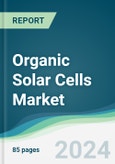Organic solar cells (OSCs) are categorized as third-generation solar cells containing organic polymers. OSCs are one of the emerging photovoltaic (PV) technologies and are used in electronics for charge transmission and light absorption. In terms of design and adaptability, organic solar cells outperform conventional solar cells, which is projected to spur industry expansion. Technological advancement and product innovations are paramount for the organic solar cell market. Consistent R&D promotes greater efficiency, better stability and durability, and lower cost of production, increasing the competitiveness and affordability of organic solar cells.
Market Trends:
- Growing demand for cleaner energy and supportive government policies: To address the rising energy demands of the 21st century, there is a significant shift toward green and renewable energy sources, with solar energy emerging as one of the most reliable options. Rapid population growth, industrialization, and technological advancements are driving the need for substantial energy supplies. According to the International Energy Agency (IEA), solar photovoltaics (PV) account for 60% of renewable energy. Utility-scale solar PV is the most cost-effective option for expanding power generation in most countries, especially amid rising natural gas and coal prices. Policy measures in regions like China, the European Union, and India are accelerating the deployment of both commercial and residential solar PV projects.
- Global shift toward clean energy solutions: The worldwide push for cleaner energy sources is a major driver of innovation in the solar energy sector. Organic solar cells are gaining attention as a potentially more environmentally friendly alternative to traditional silicon-based solar cells.
- Asia-Pacific’s market growth: Governments across the Asia-Pacific region are implementing various policies and programs to combat climate change by promoting low-energy infrastructure, which is boosting the demand for organic solar cells. For example, India’s PM Surya Ghar Muft Bijli Yojana provides subsidies of 60% for rooftop solar systems up to 2 kW and 40% for systems between 2-3 kW, with a maximum benefit cap of 3 kW, encouraging households to adopt solar energy solutions.
Key Benefits of this Report:
- Insightful Analysis: Gain detailed market insights covering major as well as emerging geographical regions, focusing on customer segments, government policies and socio-economic factors, consumer preferences, industry verticals, and other sub-segments.
- Competitive Landscape: Understand the strategic maneuvers employed by key players globally to understand possible market penetration with the correct strategy.
- Market Drivers & Future Trends: Explore the dynamic factors and pivotal market trends and how they will shape future market developments.
- Actionable Recommendations: Utilize the insights to exercise strategic decisions to uncover new business streams and revenues in a dynamic environment.
- Caters to a Wide Audience: Beneficial and cost-effective for startups, research institutions, consultants, SMEs, and large enterprises.
What can businesses use this report for?
Industry and Market Insights, Opportunity Assessment, Product Demand Forecasting, Market Entry Strategy, Geographical Expansion, Capital Investment Decisions, Regulatory Framework & Implications, New Product Development, Competitive Intelligence.Report Coverage:
- Historical data from 2022 to 2024 & forecast data from 2025 to 2030
- Growth Opportunities, Challenges, Supply Chain Outlook, Regulatory Framework, and Trend Analysis
- Competitive Positioning, Strategies, and Market Share Analysis
- Revenue Growth and Forecast Assessment of segments and regions including countries
- Company Profiling (Strategies, Products, Financial Information, and Key Developments among others)
Organic Solar Cells Market is analyzed into the following segments:
By Type
- Single Layer
- Bilayer
- Bulk Heterojunction Organic Cells
By Application
- Conventional Solar Applications
- Mobile Applications
- Military-Based Applications
- Building Integrated Photovoltaics (BIPV)
By Region
- Americas
- United States
- Others
- Europe, Middle East & Africa
- Germany
- France
- Others
- Asia Pacific
- China
- Japan
- Others
Table of Contents
Companies Mentioned
- Mitsubishi Chemical Holdings Corporation
- Armor Group
- NanoFlex Power Corporation
- GenesInk
- Heliatek
- Epishine
- Solivus
- Moresco Corporation
- Solarmar Energy Inc.
Methodology

LOADING...
Table Information
| Report Attribute | Details |
|---|---|
| No. of Pages | 145 |
| Published | February 2025 |
| Forecast Period | 2025 - 2030 |
| Estimated Market Value ( USD | $ 189.59 Million |
| Forecasted Market Value ( USD | $ 333.17 Million |
| Compound Annual Growth Rate | 11.9% |
| Regions Covered | Global |
| No. of Companies Mentioned | 9 |









